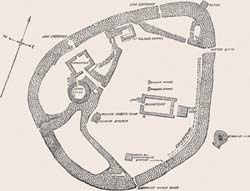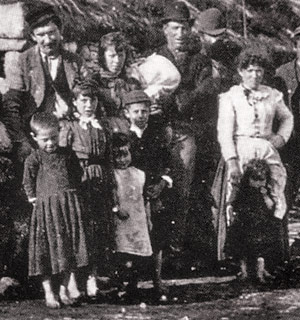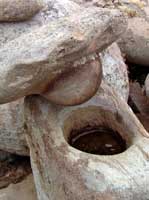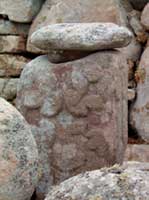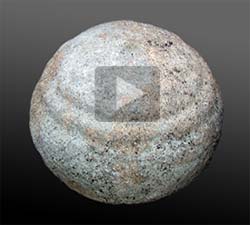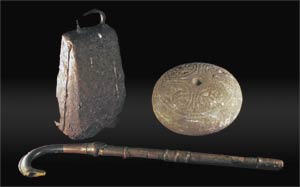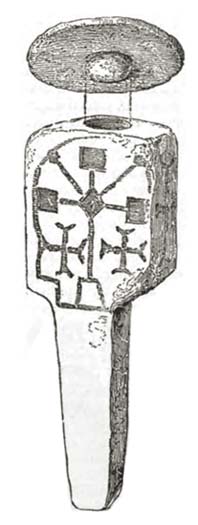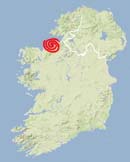07 Aug Inishmurray Monastic Site
“The tourist who has ever travelled the highly picturesque road from Sligo to Bundoran, which runs between Ben Bulben and the sea, cannot fail to have noticed the island of Inismurray [sic]. Long and low-lying, it looks in the distance like a huge raft at anchor in the broad waters of the noble bay of Donegal. Being very difficult of access, it is seldom visited by strangers, and yet few ancient sanctuaries ought to be more interesting to the churchman and antiquarian. It is undoubtedly one of the very earliest of the Irish monastic retreats…More than thirteen hundred years have passed since St. Molaise first built his church and cell in this desolate island; time and the spoiler’s hand have not spared these venerable ruins, but the shadow of its ancient holiness is around the island still.”
J.H., “A Pilgrimage to Inismurray,” 1877 1
“Saved by its ocean walls from ordinary marauders in former times, and from the wanton tourist of to-day…Inismurray [sic] has retained a larger number of examples of primitive Irish Art than perhaps any other early Christian settlement in Ireland.”
William Wakeman, A Survey of the Antiquarian Remains on the Island of Inismurray, 1893 2
Drag within the image to explore the Inishmurray sites in virtual reality.
An interactive map will appear when you click the button to enter full-screen mode.
Touch here for the mobile version.
The story of Inishmurray is a tale of two communities, each now deserted, each in its own era confronting great challenges. Today a visitor on a day trip from Mullaghmore might be tempted to idealize an imagined life on a small island 7 km (4.4 mi) out in Donegal Bay, with a postcard-perfect view of Ben Bulben and Knocknarea at the front door. But the monks who lived here were terrorized by the Norsemen starting early in the ninth century, forcing them to take their monastic life to the mainland. And in the modern era the last six households of Inishmurray—46 souls—abandoned their modest homes in 1948, trading their lives of sparse but splendid isolation on an island with neither doctor nor priest for cottages on the Sligo coast.
In the virtual-reality environment above, the red hotspots will take you from the boat approaching Inishmurray to a view of the abandoned 19th-century homes, and from there to seven views around the early medieval monastic enclosure, the Cashel (Caiseal). Click the “full-screen” button to use the interactive map.
The island was created around 7,000 BCE, when a global rise in sea levels inundated low-lying parts of the Irish coast, creating here a squat sandstone shelf, no higher than 21 m (70 ft) above the water, and 3.75 km (2.3 mi) long by .75 km (.5 mi) wide. The island sits so low to the sea that during World War I the captain of a British warship mistook the Cashel for the conning tower of a submarine and promptly torpedoed the island. There were no casualties, except to the pride of the captain.3 In a geological twist that would become a boon to its eventual occupants, the western end of the island features numerous narrow finger-like indentions, forming miniature natural harbors. These are known as “classeys” from the Irish clais, a furrow. But the same forces of nature that created Inishmurray are now, due to global warming, threatening its cultural treasures.
Archaeological sites dating from the Neolithic to the later medieval period, originally sited a safe distance from the sea, are now on the shore or cliff-edge. Many are already washed out to sea and every year incremental rises in sea level are placing settlements, graveyards and middens under threat.4
The first people to settle on what would be known as Inishmurray may have arrived as early as 2,000 BCE. We have no evidence of their domestic lives, but an ornamented votive food vessel, found in 1938 in a Bronze Age cist, casts a light on their funerary practices.5 Early antiquarians suggested that some of the decorated stones found in the ecclesiastical enclosure were examples of prehistoric rock art; however most archaeologists now presume these fragments and the decorated “cursing stones” (see below) to be of early medieval origin.6
The first serious study of the ruins at Inishmurray came when the artist and antiquarian Gabriel Beranger visited the island in 1779. Many of Beranger’s original drawings from this visit were unfortunately lost, but copies were created and may be seen in the gallery below. Beranger, and his companion Angelo Bigari spent three days on the island, which they regarded as an Eden of innocents, comparable to Tahiti, which even provided them lobsters for dessert.7 While the Dutchman had no command of the Irish language, he had taken the trouble to learn one phrase that would prove itself useful: Torum pogue Calinoge [sic], which means, “give me a kiss, young girl.” The distaff natives, Beranger reported, dutifully lined up for a smooch with the artist.8 The distinct lack of chivalry displayed by the visiting artist in 1779 had, by William Wakeman’s report of 1892, been replaced by an admonition to the “gentler sex:”
British military surveyor Charles Vallancey, who made a second career of proposing preposterous foreign origins for many Irish monuments, apparently did not himself ever set foot on the island. Nevertheless he suggested in 1786 that the monks’ cells of Inishmurray were “artificial caves for the worship of Muidhr, or the Sun, from which the island…takes it name, Inis Muidhr.”10
The more lasting insults to the monastic ruins of Inishmurray were not the speculations of Vallancey but were rather the modifications made during the 1880 “restoration” by the government agency charged with the site’s protection. The Board of Works stone masons, perhaps in their zeal to pay homage to their medieval forebears, created entrances where there were none and wall niches where they thought they ought be placed. They then decorated the niches by “wantonly transferring several early gravestones” into them.11 Fulminating upon this reconstruction, Wood-Martin wrote in 1895:
“The entrance [was] rebuilt, but in such a manner that the ghost of the Firbolg architect may be supposed to wring his hands nightly beside it in despair, lest the nineteenth-century gazers should imagine him to have been the originator of such work…When the stones become weathered and lichened, it will remain ‘a mockery, a delusion, and (probably) a snare’ to future inquiring antiquaries.” 12
Similar complaints were made about Board of Works’ restorations on the monastic remains of Skellig Michael in Co. Kerry. Wakeman’s extensive 1885 survey on Inishmurray was commissioned largely in response to the unfortunate and undocumented 1880 restoration, and is recognized today for its systematic and thorough fieldwork.13
Although Inishmurray was named after the fifth-century St. Muiradach, the Bishop of Killala consecrated by St. Patrick himself, its most renowned religious personage is surely the legendary founder of its sixth-century monastic settlement, St. Molaise, also known as St. Laisrén mac Decláin. While he is mentioned in the Martyrology of Donegal as the confessor of St. Columba (Colm Cille), there is no written hagiography of St. Molaise that has survived. Nor is there any substantial reference to the monastery at Inishmurray after the report of its Viking conflagration of 807. There is, however, an oral tradition that extends the monks’ tenure on the island until the end of the 12th century.14 While the monastery may have been deserted for 600 years by the time Fr. John Healy wrote of his visit to the island in 1877, the folk memory of its founder persisted:
“They have no opportunity of hearing Mass on Sundays; but they never fail to say the rosary, either in their own houses, or, when the weather is fine, in the little chapel of St. Molaise, the patron of the island. They invariably call him “Father Molosh.” Though dead, his spirit rules them; he is reverenced and spoken of as if still living amongst them, like a parish priest, able to hear their complaints and redress their grievances.” 15
There has never been a detailed archaeological excavation of the monastic settlement on Inishmurray, known as the Cashel, or Caiseal. Thus there is no way to completely dismiss the suggestion that the structure predates St. Molaise’s religious community.16 It may be that the walled Cashel was constructed as a defensive domestic space that was subsequently transformed into a monastery. It is likely that the monastic community had ceased to exist on the island prior to the complete suppression of the Celtic Christian tradition by the Anglo-Normans after their 12th-century invasion. This sequence of events may help to provide a context for the cursing stones (see discussion below) and the even more enigmatic decorated “bottle and stopper” stone block (see photographs below, right). While it is possible that this 70 cm (2 ft) stone may have had some domestic function, it is more likely that it had an entirely ceremonial purpose. Clearly it cannot easily be explained by any accepted practice of the Roman Church, and so must belong to either an early Celtic Christian observance, or even to a pagan ritual that predates both the sixth-century monastery and the arrival of the first Christian evangelists to Ireland a century earlier. As Peter Harbison put it, “There is…no way of knowing for certain which came first, the monastery or the egg-shaped enclosure.”17
History does not record what caused the community begun by St. Molaise to abandon its remote island fortress. It may be but a coincidence that the last two accounts of the monastery in the Annals were of the Norsemen’s depredations of 795 and 807. Did the horrific terror of the heathens from the north persuade the monks to move their house to the mainland within the next century or so?18 There is no evidence of any population at this time outside the monastic community; if under assault there would be no local allies that the isolated religious group might turn to. Island legend however, as retold by Joe McGowan, depicts a very different conclusion to the conflict.
According to folklore, after the first Viking raid the monks arranged with their compatriots on the mainland that if again threatened by invasion they would light fires requesting assistance. When the Vikings began their next assault the mainland villagers responded with an armada of small boats to assist the monks.
“The Danes went into the monastery to plunder it. All the people that came to help attacked. They came up out of the coves and hides they had on th’island an’ the slaughter commenced.
The Danes retreated to their boats to see would they get away off th’island. When they went down to where they were anchored, the tide was out an’ the boats were stranded…They were slaughtered to a man except for one of the Danish chieftains they called Galliagh Rogach. They brought him over to a rock an’ there came an old woman down out of th’island. She had a hatchet with her.
‘Put that gadai’s [robber’s] head on the rock an’ I’ll execute him meself,’ says she.
They put his head down on a big boulder an’ the oul’ woman came over an she chopped the head clane off the Dane.” 19
The Cashel
The dry stone walls of the Cashel and its monastic remains, dated to the ninth century, probably replaced an original sixth-century monastic outpost of wood and thatch construction. The monastery may have been long deserted by the time Inishmurray’s first secular neighborhood was built—perhaps as early as the 12th century. The ruins of St. Molaise’s monastery, however, continued to serve as the center of the island’s spiritual life into the modern era, with folk practices that may have borrowed as much from pagan beliefs as from Catholic sacrament. With no resident priest to conduct a Sunday Mass, the islanders instead assembled in the Cashel to perform their devotions. The enclosure was also used at the burial place for the men of the island, with the women interred outside the Cashel near the Women’s Church at Templenaman, now at the cliff’s edge.20
The massive dry stone wall that defines the monastic site, as reconstructed in 1880, is 3 m (10 ft) high; a bit shorter than was reported in 1836 when it was measured at 4.6 m (15 ft) in height.21 The egg-shaped enclosure measures 52.5 m by 40.5 m. (172 ft) x 132 ft) and its walls are up to 4 m (13 ft) thick. There are low walls defining three subdivisions within the Cashel. Although an earlier visitor, prior to the 1880 reconstruction, reported seeing no above-ground entrance to the Cashel, archaeologists today consider the three ground-level openings in the south and northwest sections to be the original entrances.22 There are at least two souterrains or underground passages found in the enclosure. A number of the structures within the Cashel are identified in the virtual-reality environment, top left.
Teach Molaise
St. Molaise’s House is likely the earliest structure in the Cashel, perhaps dating from the eighth century, and replacing one that would have been constructed of wood or wattle. This is traditionally considered to be the founder’s shrine chapel, a small oratory where the saint’s altar and stone bed were venerated. The islanders used this church on Sundays for their self-led devotions, facing the little wooden statue of St. Molaise on the altar. The statue, now removed, is discussed below.
An early example of the use of mortar in Ireland,23 this building is 2.7 m long by 2.8 m wide. Its (locked) doorway has a simple Greek cross inscribed on the lintel. The mortared stone roof is now covered with grass. Some parts of this church were rebuilt in the Late Medieval period, and then further altered in 1880. Island legend holds that Teach Molaise had the capacity to hold an unlimited number of people, its interior space miraculously expanding when needed. Islanders pointed out some red markings on a flagstone near the entrance as the blood of the last abbot of the monastery, slain there by the Vikings in 807. On each Christmas Eve, it was said, a light could be seen shining from the doors and windows of the building.24
Teampall na Teine or Teach na Teine
The Church (or House) of the Fire is also described as the “monastery kitchen.” This building could be c. 14th century but may have been built atop an earlier structure. The Board of Works reconstructed it in 1880. In the center of the building is the fabled Leac na Teine, or Stone of the Fire, once an altar but now reduced to a stone in the center of the floor.25 The islanders believed that if all their fires were extinguished they could place a bit of turf on the Leac na Teine and it would burst into flame.
“Bursting into flame” was, according to island lore, exactly what occurred to the defiling visitor to the island who decided to relieve himself on the stone. According to Wakeman’s retelling:
“The fire which up to that fatal moment had been scarcely visible, at once flared up, and swiftly assumed the strength and appearance of a burning fiery furnace, its flames lapping and enveloping the wretched victim, so that he could neither struggle against them or fly, and stood melting, as it were, into nothingness, so that after a moment little remained but fragmentary bones, cracked and distorted.” 26
At one time the islanders could point out the fragments of his burnt bones stored in a wall niche of Teampall na Teine, but they are no longer to be seen. A perpetual flame is also associated with the pagan “fire house” next to St. Brigid’s Cathedral and round tower in Kildare.27
This building is 5.1 m (16.7 ft) long by 3.4 m (11 ft) wide. A cross on the lintel may be evidence of a reused cross-slab grave marker. The building’s “hearth,” which may be source of its fire-centered folklore, is a group of flat stones set into the floor forming a square outline about 1 m (3.3 ft) wide.
Templemolais, or Teampall na bFear
The Church of the Men, also known as the “Monastery,” is the principal church inside the Cashel. It has three pillar stones aligned on either side of its west gable, and two bullauns (stone basins) next to the building. The structure is 7.73 m (25.4 ft) long by 3.55 m (11.6 ft) wide. The round-headed east window was likely reconstructed by the 1880 Board of Works project. Unfortunately there is no clear visual distinction between the medieval masonry and the 19th-century reconstruction. Mortar from the building yielded a radiocarbon date of c. 800-1150 CE. The sample came from what may have been a secondary phase of the building.
A standing stone next to Templemolais has two large holes on its sides and two smaller holes on its rear face. This stone may be explored in three different views within the virtual-reality environment, top left. It is linked in folklore with rituals connected to fertility and childbirth. It was recorded that island mothers-to-be would kneel in front of the stone, holding on by inserting their fingers into the large side holes and their thumbs into the smaller hole on the face of the stone (see illustration in the VR tour). The islanders claimed that “death at childbirth was unknown among them.”28 This practice was also reported at a similarly holed stone just outside the Women’s Church (see photo in gallery). Archaeologists have suggested that the large side holes were originally intended to hold the wooden arms of a cross, while the smaller holes on the rear face of the stone were for the nails used to secure the cross arms.29
Tur UI Bhreanaill (Tory Bhrennel)
“O Brenall’s Tower,” once known as the “Schoolhouse,” is one of two clocháns, or beehive huts, found in the Cashel. When Wakeman visited he was told that the clochán used to serve as the schoolhouse for the islanders. The other clochán noted in the VR environment is called Tráthán an Charghais (the Lenten Station).30
Clocha Breaca (leacht and cursing stones)
While the villagers of Inishmurray preferred to refer to them as “speckled stones,” or even “holy stones,”31 these are best known as “cursing stones” for the way they were deployed in folk practice. The leacht (standalone altar) that serves as a platform for the large and diverse group of surf-rounded stones is centrally sited in the Cashel, between Templemolais and the “Schoolhouse” clochán. Some 14 of the stones associated with the leacht have carved decorations, with Greek crosses and concentric circles. In 2008 there were but eight of these reported in situ,32 with others in the National Museum of Ireland, and at least one sold, with dubious legality, to a private collector in an earlier time (see photo, below, right).33 The decorated “bottle and stopper” stone block (see photographs, right) and another resembling a squat bottle with a stone stopper, were also situated on the leacht alongside the cursing stones. Other decorated slabs may be seen here. In 2013 most of the decorated clocha breaca were removed by the Office of Public Works (OPW), and subsequently replaced by cast replicates. Other stones have been moved for safekeeping into the island’s 1889 schoolhouse, which has been refitted as an OPW repository.
Legend holds that the total number of stones cannot be known; each attempt to count them will result in a different number. The most notorious magical power however, lay in their ability to direct unnamed evil forces upon an enemy. A notation on a late 16th-century map is the earliest known reference to the cursing stones:
“In this land there dwelleth a holy man named Scanlan of whom the country people held a superstitious opinion that if he be angry with anyone he turns the speckled stones upon them, that he keepeth for that use, they shall die within that year.” 34
While there are differing accounts of the precise practice, generally if a resident of Inishmurray wanted to evoke the malevolent powers of the stone he would first complete a difficult nine-day ritual: fasting completely for three days, then taking only a single meal for the next three days, followed by three days of eating normally. When ready for the cursing, he would walk around the Clocha Breaca altar widdershins (anti-sunwise), turning the stones counter-clockwise three times while voicing his curse with each turn. But this must only be attempted when it was clear that the curse would be justified; otherwise the curse would recoil on the curse-giver himself.35 Cursing stones are known from other locations in Ireland, such as the Killinagh churchyard in Co. Cavan, but the ritual required to evoke their power is more intricate by far at Inishmurray.
In the most notorious deployment of the stones’ power, it was recorded that an Englishwoman made a special trip to the island during World War II expressly to turn the stones against Hitler, which apparently worked out very well for the Allies. In another oft-told tale, the islanders evoked their cursing stones against an offending crew of His Majesty’s Coastguard in the early 1880s. The result: the sailors all perished at sea.36
“When vengeance is desired…the stones are thrice turned, the curse being ‘loosed’ at each revolution…Woe to him, however, who anathematizes his neighbour wrongly, as the curse can have no effect on the innocent, and is sure to recoil, exactly as uttered, on the head of the issuer.” 37
Here is a “virtual Inishmurray cursing stone.” If you feel that you have a justifiable reason to evoke a curse on an antagonist, click on the image to the right, and then drag to turn the stone counterclockwise while reciting your curse. Here’s a sample curse if you would like some inspiration. But…you’ve been warned.38
Relics
Of all the treasured relics to have emerged through the centuries of relative isolation at Inishmurray, one is celebrated for its ability to survive adversity, although its face is damaged and both arms are broken off below the elbow. This 142 cm (4 ft, 8 in) oaken statue, said to represent St. Molaise (see photo, below, left), was kept on the altar of Teach Molaise in the Cashel. When the island was evacuated in 1948 it was moved to the National Museum of Ireland for safekeeping, despite the wishes of the departing islanders, who might have been comforted thinking of ” Father Molosh ” resting still in his place on their island home.39
The statue was at one time threatened by these same islanders, or their forebears, who would chip away pieces of wood from its base to send their relatives abroad who, in times of trouble. requested the holy slivers. To rescue the statue from being picked apart, the curate who ministered to the islanders encouraged them to substitute religious medals he provided, each one touched to the statue to borrow its special powers.40
Among the Inishmurray natives the statue was thought to be a work of the fabled sixth-century craftsman, the Gobán Saor, while others speculated that it could be a figurehead removed from one of the wrecked ships of the Spanish Armada. However, those familiar with such statuary consider that it most likely dates to the end of the 13th century.41
The statue first demonstrated its legendary resiliency in the19th century, when a Protestant reformer took the representation of St. Molaise and put it into a blaze of turf. But this vandalism failed, as “he came out the same as he went in.”42 Another time, a missionary took it out to sea and threw it into the waves.
The statue, however, though thrown into the sea, with the receding wind and tide, was found on shore next morning; and the islanders stoutly assert that if “Father Molosh” was thrown out in mid ocean he would return, in spite of wind and tide, to the island that he loved so well.43
Other relics of ancient Inishmurray do not enjoy the same climate-controlled retirement in Ireland’s National Museum. Three historically—and symbolically—important artifacts from Inishmurray, a decorated cursing stone, plus a bell and a copper-clad wooden crozier (staff) both ascribed to St. Molaise, somehow were obtained c. 1842 by landowner and antiquarian looter Roger Chambers Walker, and were displayed in his private museum near Sligo town.44 With the dispersal of this museum collection, the Inishmurray artifacts (see photo, left) were purchased in 1851 by the Duke of Northumberland and became part of his collection at Alnwick Castle. Read more about this here, and sign a petition for the repatriation to Ireland of these important Inishmurray relics.
The Pattern
“The origins of the pattern day, with its devotional circuit and prescribed prayers, are certainly much older than our earliest written description of the practice…It now seems certain that some form of ’rounding ritual’ was established on Inishmurray by the end of the first millennium or the beginning of the second.” 46
For hundreds of years, perhaps beginning soon after the time of the monastery, the 15th of August saw the islanders, joined by pilgrims from the mainland, perform the 16 stations comprising the “pattern” of Inishmurray. With a careful adherence to the long-established ritual prayers and physical deprivations, the pilgrims would perform the rounds in anticipation of obtaining a favor or in thanksgiving for one previously granted. Another term for the penitential practice is turas, or “procession.” For a detailed description of a similar turas, see our pages on Gleann Cholm Cille (Co. Donegal).
The date of the Inishmurray pattern is the Feast of the Immaculate Conception, which, as Peter Harbison noted, is “sufficiently close” to the accepted St. Laisrén mac Decláin [St. Molaise] feast day of August 12.45 This tradition was mentioned by Beranger in 1779, and was described in some detail by Wakeman in 1886. Sadly, a practice that began in antiquity was ended with the exodus of the Inishmurray islanders in 1948.
Most accounts of the pattern agree that it began and ended in the Cashel, with its stations reached in a long clockwise traverse about the periphery of the island. According to some, three circuits were also made atop the Cashel wall. Although the principal monuments of the Cashel are important focal points of the pattern, a number of the widely distributed drystone altars or leachta elsewhere on the island were visited as well. Also included was a hermit cell, known as Trahanareear, located at the westernmost point of the island.47
Dr. Patrick Heraughty, a sixth-generation descendant of one of the original Inishmurray re-settlers of 1802, lived on the island until 1924.48 He died in 2005, just short of his 93rd birthday. Using his own recollections, plus his notes from conversations with his island neighbors, he published the first edition of Inishmurray, Ancient Monastic Island in 1982. His text includes a detailed description of the stations and traditions of the Inishmurray pattern.49
Island Life
A visitor to Inishmurray today is likely to be interested either in archaeology or ornithology, as the island has since 1948 been left to the birds (most notably the barnacle geese). However the island was almost completely depopulated once before. Gabriel Beranger reported a population of 45 in 1779, who informed him that they “inhabited the island in succession these five or six hundred years.”50 But declining interest in coping with the challenges of life on a small island had caused the population to dwindle to just a single household by the start of the 19th century. In 1802 the owner of the Inishmurray estate was determined to revive these numbers, and his land-tenancy revenues. He made an “offer he couldn’t refuse” to Domhnall O’Heraughty, author Patrick Heraughty’s ancestor, by arranging for O’Heraughty’s marriage to a woman willing to accompany him to a life on the nearly-deserted island. Others soon followed, with the island population growing to 102 in the 1880s before it began its final slow decline.51 A 1912 census listed some 30 buildings, including both homes and barns. The houses all fronted onto a single unpaved road that extended along the southern side of the island, facing the mainland. A group of three unoccupied homes still standing in 1999 may be seen in the virtual-reality environment, top left.52
“The live stock consists of a few small and weather-beaten cows and sheep, who contrive to live, with some difficulty, on the scanty herbage. There are no horses, but there are a few peculiar specimens of the donkey tribe; how they make off life no one knows, nor do they seem to belong to anybody in particular. Perhaps, like the people themselves, they are aborigines—the sole descendants of an ancient race.” 53
On Inishmurray, especially during the long, cold, dark winter nights, the only entertainment was what came from the islanders themselves. There would be fiddle music, dancing, and singing, and all with a bottle of the local spirits being passed around. Stories from Irish mythology, ghost tales, and the lore of an enchanted island waiting beyond the Atlantic horizon were handed from one generation to another. One unique tradition occurred on St. Brigid’s Eve (February 1) when, as in much of Ireland, revelers carried a figure dressed to represent the saint and paraded it around bonfires. Here, however, the islanders made use of these festive bonfires to roast and then feast upon their abundant lobsters.54
“Surrounded by the fierce and unpredictable ocean, battered by Atlantic storms, and every day wresting a living from unyielding soil…unseen and uncontrollable forces were all around.
…
On winter nights when the wind spent its fury against the walls, and thunderous billows crashed into the chasm called Poll a’ Sean Toinne [Hole of the Old Wave], men, women and children gathered around the hearth. The leaping flames danced on the delighted faces of storytelling ‘ramblers’ circled around it. The cheery light threw flickering shadows on the whitewashed wall behind; dancing flames and spiraling smoke inspired and stirred the imagination of storyteller and listener alike.” 55
In his book of islanders’ recollections, Inishmurray, Island Voices, historian and Inishmurray tour boat operator Joe McGowan has assembled a treasure-trove of stories and folklore from the island. Brief descriptions of some of these are listed in this footnote link.56
The islanders made their livings in various ways. Fishing might seem to be the obvious occupation. But this did not come naturally to the mainlanders who re-colonized Inishmurray in the early years of the 19th century. Initially these farmers-turned-mariners would only use rowboats. It was reported, as they were learning to sail, that one man used for the purpose a bed quilt affixed to his mast. By mid-century a government agency sent a man to teach the islanders better fishing methods. Because getting the fish to market on the mainland was a problem, fish that could easily be cured prior to shipment were the most desired catch. Harvesting, drying, processing, and then shipping different type of edible seaweed also added to the islanders’ incomes. Whatever farming existed was mainly at the subsistence level, with some butter, eggs, or the occasional surplus calf sold at market in Sligo town.57
Making Whiskey
Both fishing and farming, however, were but minor factors in the 19th-century economic life of Inishmurray. The main actor on this stage was Old Inishmurray, the locally distilled illegal whiskey, reputed to be the “the purest and most delectable” poitín in the country.58 The whiskey enterprise was successful for many years due to the isolation of the island, and also the reluctance of the Revenue Police to land a small boat on the surge of an Inishmurray classey (natural harbor). When there were raids, they were usually unsuccessful because compatriots on the mainland warned the islanders when the Revenue officers were about to hire a boat. Also, the finished whiskey was kept hidden in deep recesses of the bouldered shoreline. On Inishmurray the government was always to be kept at a distance. Both before and after Irish independence, islanders did not willingly pay taxes for services they did not receive.59
The police fought back, opening a resident station on the island around 1860. This so severely impacted the fortunes of the islanders that they organized a boycott which effectively cut off supplies and communications for the police, forcing them to close down the station in 1890. Soon the cottage industry of Inishmurray returned to full production.60 Barley was grown specifically for the production of poitín. The islanders, however, would insist that it was for the purpose of giving their cattle sustenance over the cold winter months. While the barley mash was certainly intended for the still, the waste products were fed to pigs and chickens.
“Dan Brady…remembers that the hens picked at it: ‘Many’s the drunken hen or cock walked down the street of Inishmurray…you never saw anything so funny in your life. They’d be taking the two sides of the road with them.’” 61
In addition to paying close attention to their secret formulae for turning out a top-rated product, the islanders would always honor the custom of giving the first glass of each new batch of whiskey to the fairies. While crying out “Síogaí, Síogaí” (“Fairies, Fairies”) the distiller would pour out a glass for the “gentry.”62
“The otherworld people partook of the generosity of the poitín makers, and the first drop out of the still was always poured onto a clean rock for them. ‘Oh! You couldn’t run it at all if ye didn’t do that,’ Michael Heraughty declared. ‘We used to say, “Seo chugaibh! Seo chubaibh! Seo chugaibh!” (“Here’s to you!”) and tell them if they hadn’t their fill they could come to the keg and drink more. Welcome to them all!’ There were a few unbelievers who, regretting the loss of even a small drop of good whiskey, were known to add quietly, ‘and that it may choke ye!'” 63
The most notorious—and successful—police raid on Inishmurray’s economic engine happened in June of 1924 when Michael Waters, the hereditary “King” of the island, and two others were caught with eight kegs of whiskey and more than a thousands gallons of wash.
“Inspector Hughes said the whole Island was literally studded with barrels—an eloquent testimony to the trade done in treacle—and that the three defendants now before the Justice were the arch-movers in the game and were men of means. He instanced the case of a woman who was about to give birth to a child, who had no less than three barrels of wash – in a state of fermentation – in her house. He explained that it was only on account of the woman’s delicate condition that he did not take her into custody.” 64
Waters and the others were found guilty, fined, and sentenced to up to four months of hard labor. Twenty years later, with the outbreak of World War II and the rationing of sugar, distillation became increasingly difficult; the incomes of the islanders decreased significantly. This resulting economic hardship, as well as the demographics shifting away from hard-working men and toward children and old folks, were the major factors leading to the decision by the last six families to abandon the island in 1948.
The 46 Inishmurray exiles eventually moved into new council-provided housing at Moneygold on the Sligo coast, in sight of their former island homes. But the mini-diaspora of Inishmurray continued, with some islanders moving on to England, the United States, and elsewhere. A few years after the exodus, the Inishmurray farmers attempted to graze sheep on their abandoned island, but the effort failed due to the challenges of attending to the animals in the wintertime. The land where the barley grew is now covered over by a growth of ferns, some nearly 2 m (6 ft) tall.65
“The monks of old, in their choice of a home, sought not fertility of soil or sylvan beauty, but a secure asylum for prayer and penance. And in their eyes, though so bare and desolate, the place had a suitability and beauty of its own. They were effectually cut off from the world and its contagious influences. The waves murmured in unison with their morning and evening hymns of praise. The frequent storms, the changeful ocean, the distant mountains, reminded them of God.” 66
Click here to see all the notes from this page.
Inishmurray, Co. Sligo
Nearest Town: Sligo
Townland: Inishmurray
Latitude: 54° 25′ 53.8″ N
Longitude: 8° 39′ 24.5″ W
External Links:
Inishmurray Blog
Boat to the Island
More Information

